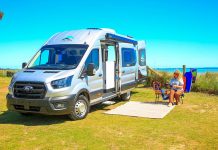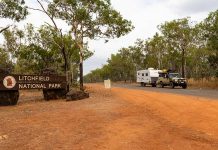I can say with some certainty that there aren’t too many campers on the Australian market quite like the Opus OP4. Nor would there be many (or any!) of this kind that could be set-up as quickly, especially if the set-up involves an annexe.
The Opus OP4 literally inflates. That’s right. An onboard air-compressor removes all of the hard work from setting it up. Gone are the days of mucking around with tent poles, swearing as you realise you’ve grabbed the wrong pole and now need to find the correct one. Push a button, grab a beer and take a seat. The camper will do the rest.
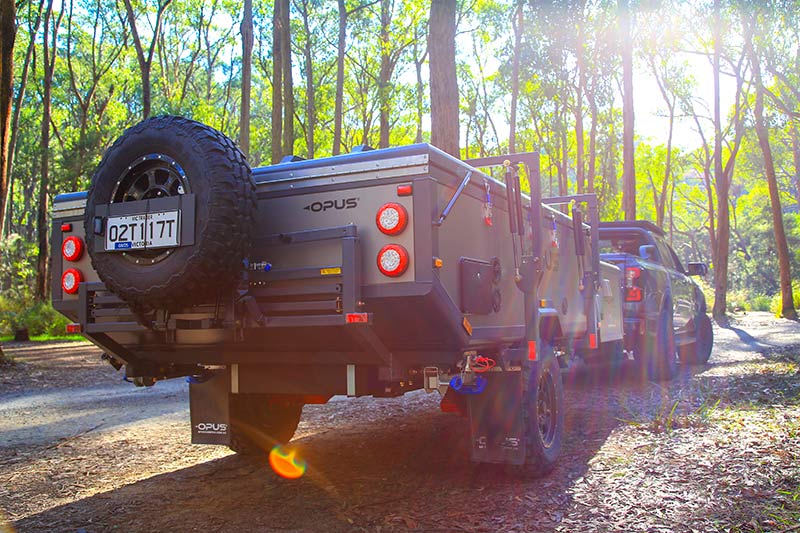 You might have seen this OP4 in action at a caravan show or perhaps online. Watching it set itself up is certainly an attention-grabber. But how does it work? And as importantly, what if there is a puncture? Let’s get into it…
You might have seen this OP4 in action at a caravan show or perhaps online. Watching it set itself up is certainly an attention-grabber. But how does it work? And as importantly, what if there is a puncture? Let’s get into it…
BEAM ME UP
The OP4 is an attractive camper, even when it’s all folded away for travel. This camper was originally released in Australia nearly 15 years as a much more rudimentary beast. While the essential shape was the same, it did involve tent poles to achieve the classic dome shape of the roof. However, there was room for improvement.
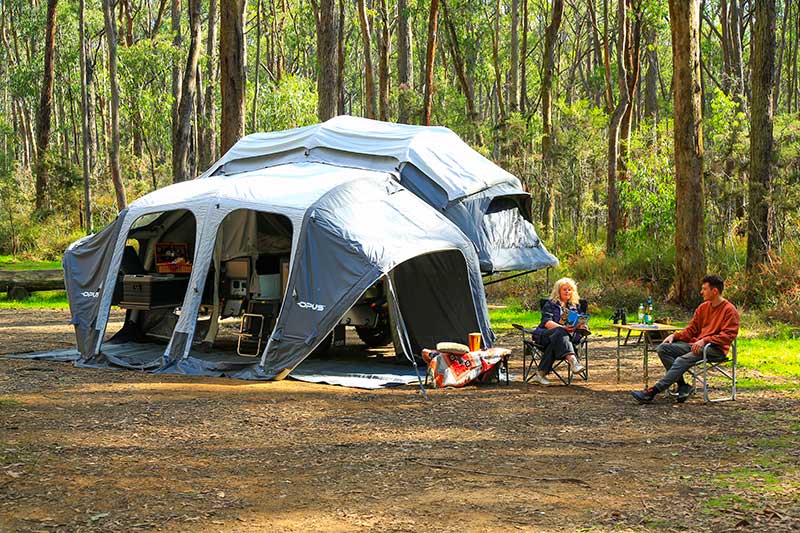 Thus, the Opus Air was born about nine years ago. Instead of tent poles to provide the shape and support for the camper’s tent section, Opus developed ‘air beams’ to replace the tent poles – when inflated to 7psi via the onboard air-compressor, these air beams become rigid and the tent section self-erects.
Thus, the Opus Air was born about nine years ago. Instead of tent poles to provide the shape and support for the camper’s tent section, Opus developed ‘air beams’ to replace the tent poles – when inflated to 7psi via the onboard air-compressor, these air beams become rigid and the tent section self-erects.
Setting up the camper, which is now known as the OP4, from go to whoa shouldn’t take more than 10 minutes, though you’d probably get it down to five after doing it a few times. First, you flip up the roof rack, which lifts easily on gas struts towards the offside of the camper. You lower the rear spare wheel, and then flip open the two lids of the camper. When open, these lids become the floor of the separate sleeping areas. The roof rack, the spare wheel and the trailer lids are all locked in their travel position via over-centre catches. Everything feels tight and solid, and if it can crash and bang when being closed, such as the roof rack, Opus has included a stopper to prevent damage.
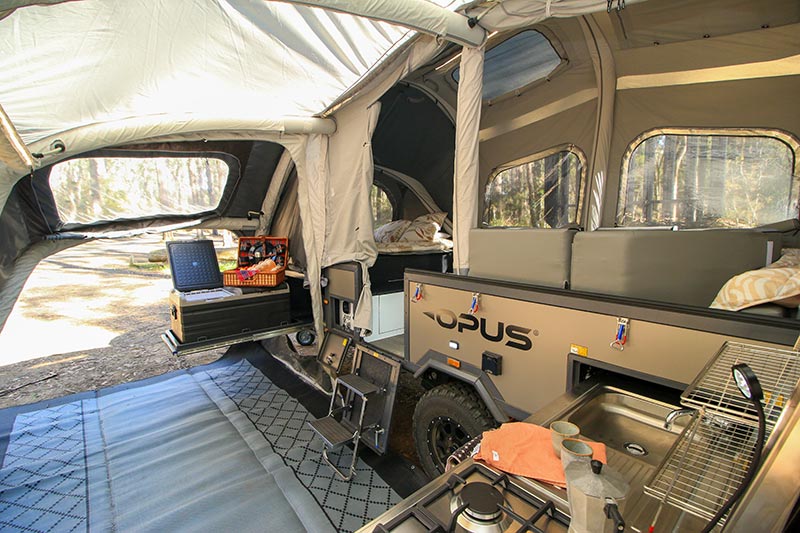 There’s a locker on the nearside containing isolation switches for all of the 12V functions of the van, including the air-compressor. Simply hit that switch when the camper is opened up and within minutes, the tent section will be up.
There’s a locker on the nearside containing isolation switches for all of the 12V functions of the van, including the air-compressor. Simply hit that switch when the camper is opened up and within minutes, the tent section will be up.
Now, our review OP4 was the up-specced TLX version, meaning it came with all the gear you can see in the pics and video, except for the portable fridge on the slide-out tray. This includes the annexe. If you like the OP4 but need a budget version, the ST variation is the one for you, but it doesn’t include the annexe. That said, there’s no reason you couldn’t purchase the annexe later on. It simply zips onto the main tent section, and inflates in exactly the same way, using the same onboard air-compressor.
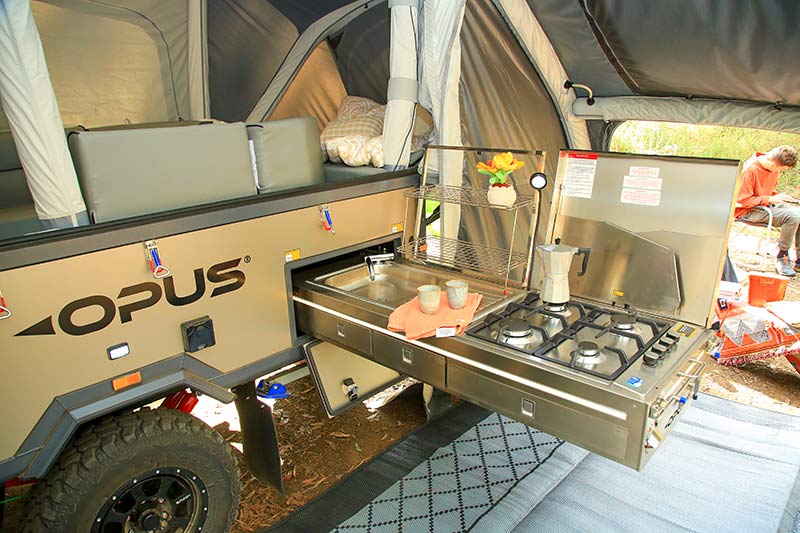 The way Opus has designed it is clever. The air bladder within each air beam is protected by an outer and inner sleeve. Opus also provides a puncture repair kit, allowing you to effect your own repairs if you find yourself in a spot of difficulty. However, you can also purchase new bladders and fit them yourself. Further, the valving system in use allows you to isolate each air beam from the other, meaning that if you can’t repair a puncture for whatever reason, you can still use the camper and annexe until you’re in a position to get it fixed. It really is a thoughtful design.
The way Opus has designed it is clever. The air bladder within each air beam is protected by an outer and inner sleeve. Opus also provides a puncture repair kit, allowing you to effect your own repairs if you find yourself in a spot of difficulty. However, you can also purchase new bladders and fit them yourself. Further, the valving system in use allows you to isolate each air beam from the other, meaning that if you can’t repair a puncture for whatever reason, you can still use the camper and annexe until you’re in a position to get it fixed. It really is a thoughtful design.
The annexe incorporates LED strip lights, too, and either end can be walled off to create two separate, private rooms to perhaps accommodate kids or guests on stretchers.
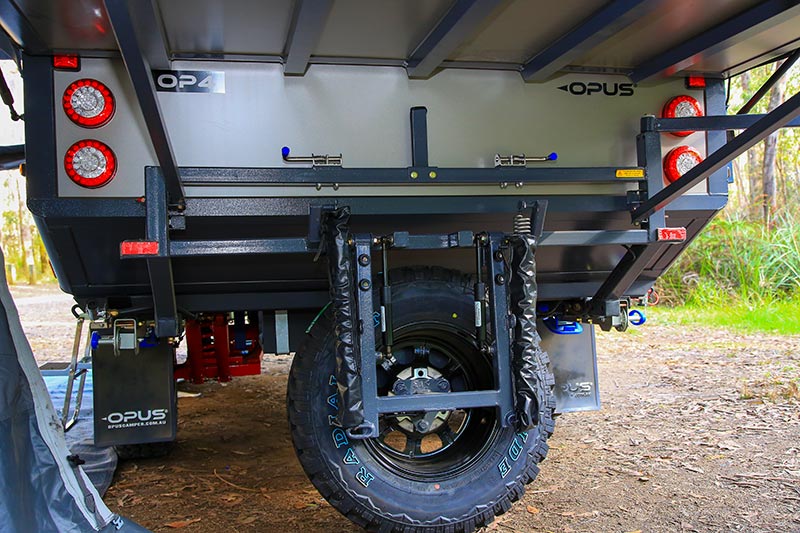 External features include the aforementioned fridge slide, which includes an Anderson plug so you can power your fridge. There’s a stainless steel slide-out kitchen, too, complete with LED lighting for nighttime cooking, a sink with hot and cold water, a slide-out tray, a pots and pans rack, and a four-burner gas stove – there are two 4.5kg gas cylinders in a storage compartment on the A-frame.
External features include the aforementioned fridge slide, which includes an Anderson plug so you can power your fridge. There’s a stainless steel slide-out kitchen, too, complete with LED lighting for nighttime cooking, a sink with hot and cold water, a slide-out tray, a pots and pans rack, and a four-burner gas stove – there are two 4.5kg gas cylinders in a storage compartment on the A-frame.
OPUS WOW-FACTOR
Stepping inside, you’ll find an interior with a lot of wow-factor. The high ceilings, the large windows, the stylish club-style lounge… it looks fantastic, especially with the side walls unzipped and the annexe in position. There’s something homey and classy about this setup.
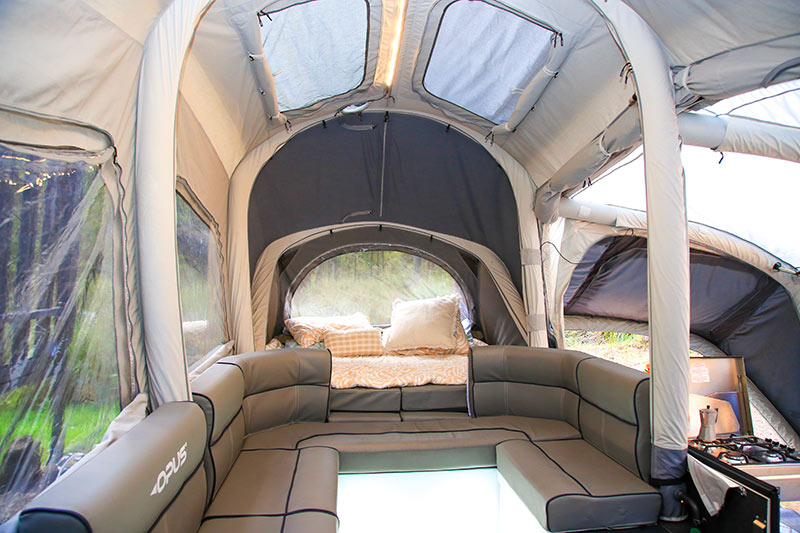 However, the interior is really just a place to sleep and perhaps eat and relax – there’s no kitchen or bathroom. The small amount of cabinetry is fabricated from folded sheet metal that contains a couple of USB and standard 12V sockets. The 12V gear is positioned beneath the shelf forward of the front bed. In this compartment, you’ll find a 2000W Renogy inverter, a 40A DC-DC charger and a 50A mains charger, while a hatch has been fitted to the floor for access to the chassis-mounted battery box (a 200Ah Renogy lithium battery is provided as standard), as is a Renogy One Core power management system.
However, the interior is really just a place to sleep and perhaps eat and relax – there’s no kitchen or bathroom. The small amount of cabinetry is fabricated from folded sheet metal that contains a couple of USB and standard 12V sockets. The 12V gear is positioned beneath the shelf forward of the front bed. In this compartment, you’ll find a 2000W Renogy inverter, a 40A DC-DC charger and a 50A mains charger, while a hatch has been fitted to the floor for access to the chassis-mounted battery box (a 200Ah Renogy lithium battery is provided as standard), as is a Renogy One Core power management system.
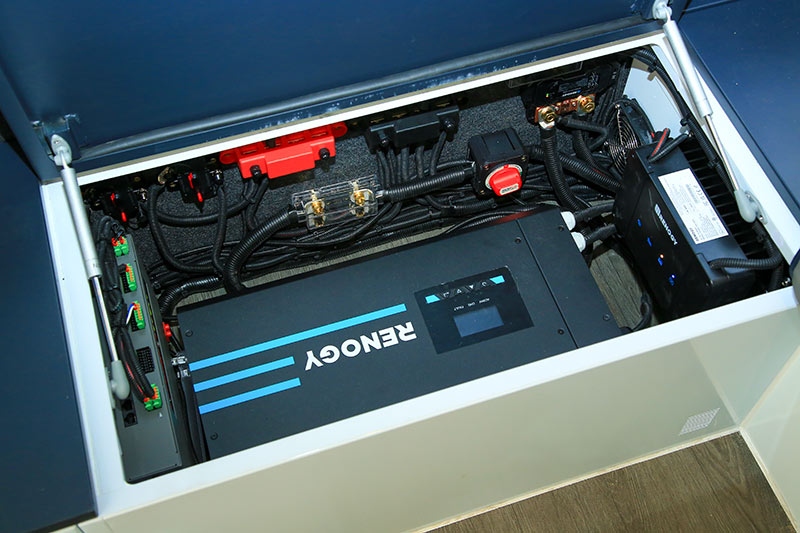 But where’s the dining table? Well, Opus does indeed provide a table, but it’s a portable unit that can be used inside or out. The same can be said of the speakers. There aren’t too many logical places to fit a set of speakers, so rather than provide an awkward solution, Opus simply provides a JBL portable Bluetooth speaker!
But where’s the dining table? Well, Opus does indeed provide a table, but it’s a portable unit that can be used inside or out. The same can be said of the speakers. There aren’t too many logical places to fit a set of speakers, so rather than provide an awkward solution, Opus simply provides a JBL portable Bluetooth speaker!
Let’s talk bathrooms. Being a camper that packs down easily into quite a compact trailer, it should’t surprise anyone that there’s no permanent bathroom setup. However, you can purchase a separate ensuite tent to mount to the roof rack. When the rack is in its open vertical position, it’s just a case of unzipping and pegging it out. Further, there’s an external shower strategically located nearby, and Opus also provides a portable toilet.
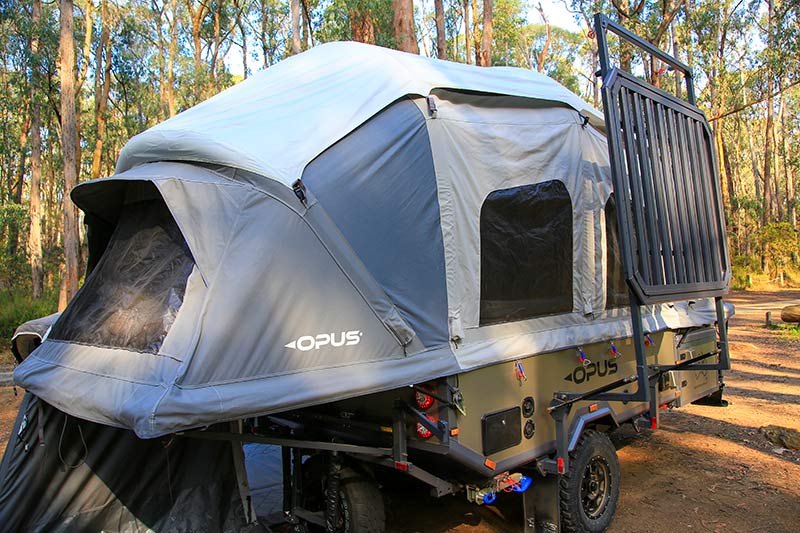 The roof rack contains T-channels and Opus provides the special nuts/tie-down points to suit, allowing you to position your tie-down points wherever it’s most convenient. The system means the roof rack can be used as a platform for most roof rack accessories from other suppliers. The A-frame-mounted storage box also features tie-down points. Combined with a slide-out offside tray, there’s a reasonable amount of external storage space on offer.
The roof rack contains T-channels and Opus provides the special nuts/tie-down points to suit, allowing you to position your tie-down points wherever it’s most convenient. The system means the roof rack can be used as a platform for most roof rack accessories from other suppliers. The A-frame-mounted storage box also features tie-down points. Combined with a slide-out offside tray, there’s a reasonable amount of external storage space on offer.
However, one thing to be aware of is the hot water situation. Like many camper trailers, the OP4 requires you to use a portable gas hot water service, which Opus can provide as an option or you can just as easily source your own. That said, the OP4 has been equipped with a support arm for a portable hot water unit that swings out from the rear spare wheel assembly, with a gas bayonet nearby allowing you to plumb it to the camper’s onboard gas supply.
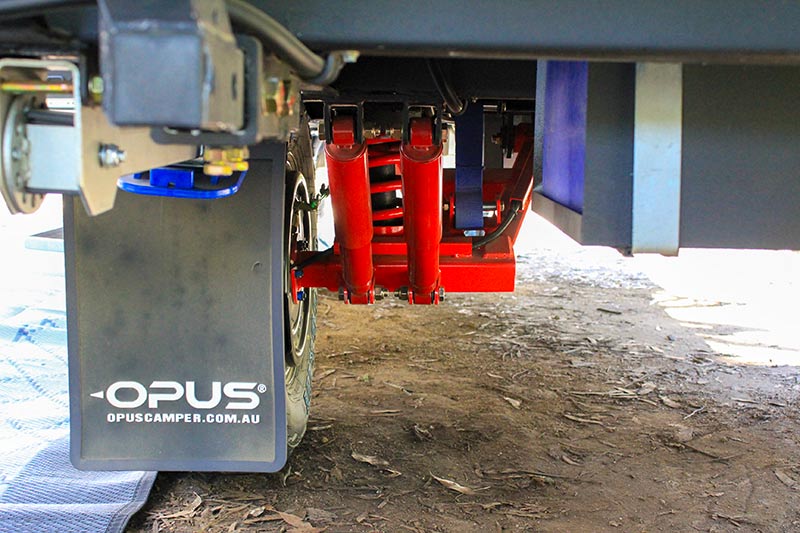 The OP4 is built atop an RHS galvanised chassis with independent trailing arm coil suspension with shock absorbers. Underneath, Opus has included 140L worth of fresh water storage capacity, while on the A-frame there are a couple of holders to suit two 20L jerry can holders. Were you to use them for water, the camper could offer 180L of onboard water storage.
The OP4 is built atop an RHS galvanised chassis with independent trailing arm coil suspension with shock absorbers. Underneath, Opus has included 140L worth of fresh water storage capacity, while on the A-frame there are a couple of holders to suit two 20L jerry can holders. Were you to use them for water, the camper could offer 180L of onboard water storage.
It all weighs a reasonable 1557kg Tare. With its ATM of 1990kg, this particular unit (noting that the Tare weigh from one to the other can be slightly different) offers a payload allowance of 433kg.
GORV’S VERDICT
There’s no doubt that the Opus OP4 offers a certain wow-factor. It’ll draw curious glances and questions from your fellow campers, that’s for sure.
While the very early Opus camper that I mentioned above had room for improvement, which was then addressed in the Opus Air, which has since become the even more refined OP4, I think the development that has gone into this rig has paid off.
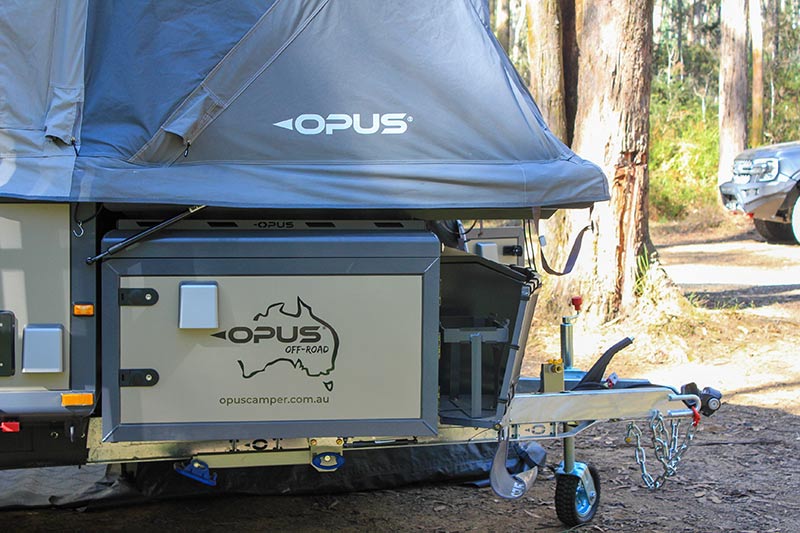 It is a well-sorted camper and Opus has thought of a solution for everything. While some solutions are portable in nature, such as the table and speaker, that’s not a bad thing. I love the fact you can isolate and repair the air beams, and even packing up the camper is not difficult. It’s one of those situations where once you’ve done it a couple times, you’ll have it down pat.
It is a well-sorted camper and Opus has thought of a solution for everything. While some solutions are portable in nature, such as the table and speaker, that’s not a bad thing. I love the fact you can isolate and repair the air beams, and even packing up the camper is not difficult. It’s one of those situations where once you’ve done it a couple times, you’ll have it down pat.
While the OP4 makes for quite a spectacle at caravan shows when being set-up, it is a very intriguing proposition.
THE SCORE
FIT AND FINISH – 
LAYOUT – 
INNOVATION – 
HITS & MISSES
- The air beams work very well and I appreciate that Opus includes isolating valves and a repair kit in the event of a puncture. The set-up and pack-down are almost effortless and take minimal time
- Wow-factor galore – prepare to answer questions at the caravan park!
- Overall, a very versatile rig
- Nothing of note; however, I reckon both the gas bayonet and the external shower could be flush-mounted units but there’s nothing inherently wrong with what’s provided
COMPLETE SPECS
Overall length: 5.6m
External width: 2.16m
Travel height: 1.64m (lid closed)
Tare: 1557kg
GTM: 1900kg
ATM: 1990kg
Group axle capacity: 2340kg
Unladen ball weight: 180kg
Frame: Aluminium
Cladding: Composite aluminium with baked enamel finish
Coupling: DO35
Chassis: Galvanised RHS
Suspension: Independent trailing arm coil with shock absorbers
Brakes: 10in electric
Wheels: 15in alloy
Fresh water: 140L
Grey water: No
Shower: External hand-held
Annexe: Annexe with air beams included in TLX package; optional in ST
Battery: 200Ah lithium with Renogy power management system, 40A DC-DC charger and 50A mains charger
Solar: No – Anderson plug provided to suit a portable panel
Air-conditioner: No
Gas: 2×4.5kg
Bike rack: No
Roof rack: Yes
Sway control: No
Cooking: External kitchen with four-burner cooktop, sink and hot and cold water (gas hot water system purchased separately)
Refrigeration: No – portable fridge purchased separately
Microwave: No
Heating: Optional
Toilet: Portable
Washing machine: No
Lighting: 12V LD
Entertainment: Portable JBL speaker provided
Portable fridge on slide-out
OP4 TLX base price: $36,999


